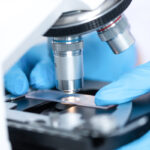Caesarean Section Stitches

İçindekiler
Toggle1- How is the skin stitched during cesarean surgery?
Following a Caesarean section, the most common skin suture methods used by doctors are:
- A stitch placed under the skin invisibly from the outside
This stitch is called subcuticular suture. Self-absorbable suture materials are used in these stitches. During this time, the stitch is not placed one by one but continuously. This stitch is commonly referred to as “aesthetic stitch”. The reason for this is that the stitch is not visible from the outside and leaves fewer scars than other stitching methods.
- Single stitch method applied to the skin using staples (wire staples)
In this stitching method, the wound edges are brought closer together by the loops placed one by one, just like wire staples. After the stitching, these staples are removed from the area where they were placed in a simple and painless manner within approximately 7 to 10 days.
- Stitching methods applied to the skin using single threads
These types of stitches do not dissolve on their own like cosmetic stitches. They need to be removed by doctors approximately 7 to 10 days after being placed.
- Adhesive tape method (strip)
A thin, transparent tape, referred to as a strip, is pasted over the wounded area and the wound edges are brought together. It is a preferred and popular suturing method for wounds that do not have much tension.
Among these methods, Methods 1 and 2 are generally preferred. Many studies have been conducted regarding the differences between these 2 methods. As a result of the studies conducted, some conclusions have been reached. These are;
Significant differences were encountered in terms of factors such as aesthetic appearance, pain, and infection.
As a result of many studies, more data has been obtained regarding the opening of the wound and the occurrence of infection in the staple closure method. However, no difference has been found in terms of wound appearance, pain, and patient satisfaction.
Another study found that the subcutaneous subcuticular suture method also provides better cosmetic results.
2- When do stitches heal?
The formation of the uppermost epithelial layer of the skin occurs within 1 to 2 days. For this reason, the patient is usually allowed to start bathing 2 or 3 days after the surgery. The skin tissue sticks together strongly and closes completely within an average of 7 to 10 days.
3- When are the stitches removed?
Normally, subcutaneous sutures that are applied regularly are not removed and they dissolve and disappear on their own. However, if non-dissolvable sutures are used, the sutures should usually be removed approximately 1 week after the surgery. However, depending on the patient’s condition, the time for removing the sutures may vary.
4- Is it normal for there to be stiffness, swelling and edema at the stitches?
It is considered normal for the areas where the stitches were placed to become hard, swollen and even bruised due to edema, usually 1 week after the surgery. It is normal for there to be slight hardness and swelling in the areas close to the stitch area, especially in the first weeks, due to edema. If these symptoms are too much, you should definitely consult your doctor. A very large and red-purple swelling may indicate a hematoma.
5- Opening (bursting) of the seam
It is not very common for a skin stitch to open or burst. Many factors such as the patient’s hygiene precautions and the stitching method play a role in this. In the event that the stitches open, the area is usually dressed and allowed to close on its own. However, if the opening is large, even if very rare, it may be necessary to put a few more stitches in that area. If the wound edges do not appear to be adjacent in the area where the skin incision is made and if subcutaneous yellow tissue is visible and fluid is coming out, then it can be understood that there is an opening.
6- Pain, burning, itching and numbness in the stitch area.
It is normal to have mild pain and burning for a few days after birth. Pain usually occurs at the ends of the skin incision and more on the right end. Feelings and numbness at the edges of the skin incision may continue for a few weeks. Occasionally, mild itching may also occur. If the pain is severe, you should consult your doctor.
7- Redness, warmth, foul-smelling discharge at the stitch site
If there is a temperature increase and redness in the stitch area, along with a yellow or green discharge that has a smell, it may be a sign of infection (inflammation). If you encounter such a situation, you should immediately consult your doctor. Clear, odorless discharge without a temperature is usually a non-infectious discharge and is normal. If inflammation is detected, the mother’s recovery process is usually observed with methods such as antibiotics and wound care, dressing, and debridement.
8- Bleeding
On the day of the surgery, it is very normal to experience slight bleeding in the stitched area. Since there is a white plaster or gauze on the stitched area, the redness that seeps into it draws attention. However, if the bleeding is heavy, it can usually be stopped very easily by applying pressure with a weight. However, bleeding should not occur from the stitched area after the patient is discharged and goes home. If there is bleeding or a red discharge, you should consult your doctor immediately.






